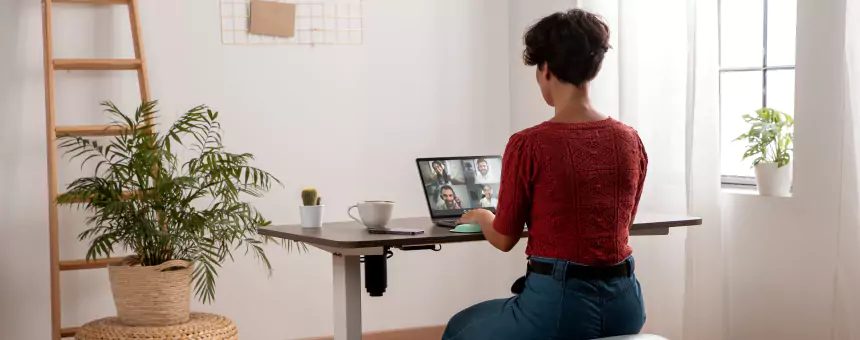In today’s dynamic work environment, comfort and productivity go hand in hand. With an increasing number of hours spent at desks, the importance of ergonomic furniture cannot be overstated. Ergonomic furniture, designed to support the body’s natural posture and reduce strain, plays a crucial role in enhancing work efficiency and wellbeing. From sit-stand desks to ergonomically designed chairs, these pieces of furniture are not just investments in office decor but in the health and productivity of individuals and teams. As we delve deeper into the benefits of incorporating ergonomic solutions into workspaces, it becomes clear that the advantages extend far beyond mere comfort.
Benefits of Ergonomic Furniture
Ergonomic furniture is specifically designed to support the body comfortably and reduce strain during long periods of sitting or standing. This furniture category encompasses a wide range of products, including chairs, desks, keyboard trays, and monitor stands, all aimed at promoting a healthier work posture and environment. The following are some key benefits of incorporating ergonomic furniture into your workspace.
Enhanced Comfort
The primary advantage of ergonomic furniture is the enhanced comfort it provides. Traditional office furniture often forces the body into unnatural positions that can lead to discomfort and even injury over time. In contrast, ergonomic furniture is tailored to support the natural curves of the body. Features such as adjustable seat heights, backrests, and armrests allow users to customize their furniture to their individual needs, ensuring maximum comfort throughout the workday. This not only makes the office a more pleasant place to be but also contributes to overall well-being.
Improved Productivity
Comfort and productivity go hand in hand. When employees are comfortable, they are less distracted by discomfort and can focus more intently on their tasks. Ergonomic furniture facilitates better posture, which in turn, reduces fatigue and increases concentration and efficiency. For instance, sit-stand desks allow workers to alternate between sitting and standing, promoting blood circulation and reducing the lethargy associated with prolonged sitting. By fostering an environment that prioritizes employee comfort, businesses can see a significant uptick in productivity levels.
Back Pain Relief
One of the most common complaints among office workers is back pain, largely due to poor posture and inadequate support from traditional office chairs and desks. Ergonomic furniture addresses this problem directly. Chairs with proper lumbar support maintain the spine’s natural curve, preventing slouching and reducing the strain on back muscles. Similarly, desks that are either too high or too low can force the body into awkward positions, but an height adjustable desk can ensure that the monitor is at eye level and the keyboard is positioned to prevent strain. For countless individuals, the switch to ergonomic furniture has been pivotal in relieving chronic back pain.
Factors to Consider When Choosing Ergonomic Furniture
Selecting the right ergonomic furniture involves more than just opting for the first chair or desk labeled as “ergonomic.” Here are critical factors to evaluate to ensure that your selection meets your specific needs.
Adjustability
The cornerstone of any piece of ergonomic furniture is its adjustability. The ability to adjust a chair’s height, tilt, and armrests or a desk’s height ensures that you can customize your workspace to your body’s dimensions and preferred working posture. Seek out furniture that can adapt to various body types and work activities.
Lumbar Support
Lumbar support is essential in preventing back pain and supporting the natural curve of your spine. When selecting chairs, pay special attention to those that offer adjustable lumbar support to accommodate your lumbar spine curvature. This feature is crucial for sustaining comfortable and healthy sitting positions over extended periods.
Materials and Construction
The materials and construction of ergonomic furniture not only determine its durability but also impact its comfort and effectiveness. Look for high-quality, breathable materials that will remain comfortable after hours of use. In terms of construction, the furniture should be sturdy and stable, with smooth adjustments and without sharp edges or pinch points. Practicality and durability should complement ergonomics; your furniture should withstand daily use while providing the benefits of improved posture and comfort.
By prioritizing these factors, you can select ergonomic furniture that not only looks good but also provides lasting benefits to your comfort, health, and productivity.
Tips for Setting Up an Ergonomic Workspace
Creating an ergonomic workspace is crucial for enhancing comfort, improving productivity, and preventing strain and injury. The right setup involves adjusting the furniture and equipment to fit your body’s dimensions and your specific tasks. Here, we delve into essential tips to help you achieve an ergonomic workstation that supports your overall well-being.
Proper Chair and Desk Height
The foundation of an ergonomic workspace is a chair and desk that complement each other perfectly in terms of height. Your chair should be adjusted so that your feet rest flat on the floor or on a footrest, with your thighs parallel to the ground. This positioning ensures minimal strain on your legs and back. Similarly, the height of your desk should allow your elbows to remain at a 90-degree angle when typing or writing. If you’re using a sit-stand desk, alternate between sitting and standing throughout the day to encourage movement and decrease the risks associated with prolonged sitting.
Monitor Placement
The placement of your monitor can significantly impact your neck and eye strain. The top of your monitor should be at or slightly below eye level, and the screen should be approximately an arm’s length away from you. This setup helps to avoid tilting your head up or down, which can lead to neck pain over time. Additionally, ensuring that your monitor is directly in front of you prevents you from twisting your neck and encourages a neutral spine position.
Keyboard and Mouse Positioning
Position your keyboard and mouse within easy reach to prevent overextending your arms, which can strain your shoulders and back. Your keyboard should be directly in front of you, allowing your arms to stay close to your body with your wrists straight while typing. The mouse should be positioned close to the keyboard so you can use it without reaching. Consider using keyboard and mouse supports that encourage a more natural hand and wrist position, reducing the risk of repetitive strain injuries.
Ergonomic Furniture Trends for 2024
The landscape of office furniture has seen a notable shift towards ergonomics, focusing on products that promote well-being and enhance productivity. Among the emerging trends of 2024, standing desks and ergonomic accessories have gained significant popularity. These trends reflect a growing awareness of the health implications of prolonged sitting and the importance of comfortable, adaptable workspace furniture.
Standing Desks
Standing desks, or sit-stand desks, have become a cornerstone of ergonomic office design. These desks allow users to easily switch between sitting and standing positions, encouraging movement and flexibility throughout the day. The benefits of using a standing desk are manifold; they can help reduce back pain, improve posture, and boost energy levels. Equipped with adjustable features, standing desks cater to the needs of individuals of different heights, ensuring that everyone can find their ideal standing or sitting position. Additionally, the variety of designs—from minimalist models to those with built-in storage—means that there’s a standing desk for every aesthetic preference and office requirement.
Ergonomic Accessories
Alongside standing desks, ergonomic accessories have also played a pivotal role in the evolution of healthier work environments. These accessories include:
- Monitor arms, which allow for the adjustment of screen height and angle, thereby reducing neck strain and enhancing visual comfort.
- Ergonomic chairs, designed with adjustable features to support the spine’s natural curvature, providing relief from back pain and improving seated posture.
- Keyboard trays and ergonomic mice, which help in maintaining a neutral wrist position, preventing carpal tunnel syndrome and related discomforts.
Together, these trends not only highlight the importance of ergonomics in modern office design but also offer practical solutions for individuals seeking to improve their workplace well-being and productivity. The focus on adjustable, user-centric designs promises a future where comfort and efficiency go hand in hand, making ergonomic furniture an essential investment for both individuals and organizations.
Conclusion
Investing in ergonomic furniture is more than a trend; it’s a commitment to enhancing your overall well-being and productivity. From relieving back pain to boosting focus and efficiency, the benefits are clear and far-reaching. A sit-stand desk alone can revolutionize your work habit, and when combined with other ergonomic solutions, it creates an environment where comfort and productivity go hand in hand.
- Ergonomic furniture promotes a healthier work lifestyle, significantly reducing the risk of musculoskeletal disorders.
- Improved comfort and adaptable workspaces lead to increased productivity and job satisfaction.
- Investing in ergonomic furniture now can lead to long-term health benefits and cost savings on potential medical expenses.
Embrace the change and invest in your health and productivity by choosing ergonomic furniture for your workspace. The advantages are undeniable, making it a wise decision for anyone looking to create a more comfortable, efficient, and healthy work environment.



